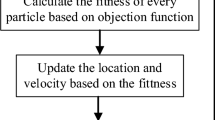Abstract
The arch is the main stress structure of metro station in the construction of arch cover method. The preliminary geological survey has some limitations, and the arch structure design based on the survey results is usually too conservative, which increases the investment cost. Therefore, it is necessary to optimize the design parameters of arch structure. In this paper, based on particle swarm optimization (PSO) algorithm, the engineering cost is taken as the optimization objective, and the monitoring control values of displacement are taken as the constraint condition. The scheme optimization is carried out for the thickness of outer primary lining and inner primary lining and removal length of temporary support. The final optimization values of parameters obtained by PSO algorithm are that the removal length of temporary support is 18 m, the thickness of the outer primary lining is 22 cm, and the thickness of the inner primary lining is 26 cm. Compared with the original design scheme, the engineering cost of the optimized scheme is reduced by 8.79%. The optimized parameters can not only meet the safety requirements of the project, but also effectively reduce the project cost, which has guiding significance to the actual project construction.












Similar content being viewed by others
Data Availability
Enquiries about data availability should be directed to the authors.
References
Adoko AC, Jiao YY, Wu L, Wang H, Wang ZH (2013) Predicting tunnel convergence using multivariate adaptive regression spline and artificial neural network. Tunn Undergr Space Technol 38:368–376
Alvarez-Fernandez MI, Prendes-Gero MB, Drouet JM, Lopez-Gayarre F, Junco JRV (2020) Application of genetic algorithms in the optimisation of steel rib supports. Tunn Undergr Space Technol. https://doi.org/10.1016/j.tust.2020.103462
Berti M, Bertello L, Bernardi AR, Caputo G (2017) Back analysis of a large landslide in a flysch rock mass. Landslides 14(6):2041–2058
Bu KZ, Zhao Y, Zheng XC (2021) Optimization design for foundation pit above metro tunnel based on NSGA2 genetic algorithm. J Railw Sci Eng 18(2):459–467 (in Chinese)
Cheng MY, Hoang ND (2014) Interval estimation of construction cost at completion using least squares support vector machine. J Civil Eng Manag 20(2):223–236
Ding M, Zhang YX (2011) Optimization of soil nailing structure based on improved genetic algorithm. Chin Civil Eng J 44(S1):171–176 (in Chinese)
Du ZJ, Liu Y (2014) Discussion on step control of surface settlement during metro station construction with arch cover method. Railw Constr Technol 04:1–4 (in Chinese)
Gao W (2006) Back analysis algorithm in geotechnical engineering based on particle swarm optimization. Rock Soil Mech 27(5):795–798 (in Chinese)
Gao X, Yan EC, Yeh TCJ, Yin XM, Cai JS, Hao YH, Wen JC (2020) Back analysis of displacements for estimating spatial distribution of viscoelastic properties around an unlined rock cavern. Tunn Undergr Space Technol 126:1–13
Hou SK, Liu YR, Zhang K (2020) Prediction of TBM tunnelling parameters based on IPSO-BP hybrid model. Chin J Rock Mech Eng 39(08):1648–1657 (in Chinese)
Li FY, Jiang AN, Zheng S (2021) Anchoring parameters optimization of tunnel surrounding rock based on particle swarm optimization. Geotech Geol Eng 39:4533–4543
Ling TH, Xie WH, Zhou K et al (2016) Tunnel-supporting parameter optimization of shallow-buried and unsymmetrically load based on the sensitivity analysis. J Transport Sci Eng 32(03):68–73
Salimi A, Rostami J, Moormann C, Delisio A (2016) Application of non-linear regression analysis and artificial intelligence algorithms for performance prediction of hard rock TBMs. Tunn Undergr Space Technol 58(5):236–246
Sun B (2014) Back analysis of physical and mechanical of tunnel based on PSO-FLAC2D. J Railw Sci Eng 11(3):135–139 (in Chinese)
Tang BQ, Han J, Guo GF, Chen Y, Zhang S (2019) Building material prices forecasting based on least square support vector machine and improved particle swarm optimization. Arch Eng Des Manage 15(3):196–212
Wang JB, Huo Q, Song ZP, Zhang YW (2019) Study on adaptability of primary support arch cover method for large-span embedded tunnels in the upper-soft lower-hard stratum. Adv Mech Eng 11(1):1–15
Wen ZW (2011) The study on anchorage mechanism of rock and optimization of anchorage parameter. Dalian Maritime University, Dalian (in Chinese)
Wu CZ, Hong Y, Chen QS, Karekal S (2019) A modified optimization algorithm for back analysis of properties for coupled stress-seepage field problems. Tunn Undergr Space Technol 94:1–7
Zhang GQ, Du ZJ, Song JQ, Cai JD, Tao TJ (2012) Monitoring and ananlysis of excavation-induced subsidence of subway station constructed by arch cover method and control measures. Chin J Rock Mech Eng 31(S1):3413–3420 (in Chinese)
Zhang Y, Yuan LJ, Cheng S (2019) Building energy performance optimization: a new multi-objective particle swarm method. In: International conference on swarm intelligence, pp 139–147
Zhang Y, Su GS, Liu BC, Li TB (2020) A novel displacement back analysis method considering the displacement loss for underground rock mass engineering. Tunn Undergr Space Technol. https://doi.org/10.1016/j.tust.2019.103141
Zhao CY, Peng LM, Shuai JB, Shi CH, Lei MF (2020) Analysis of deformation control for a large-span metro station crossing throngh fault zone using arch-cover method. J Railw Sci Eng 17(05):1193–1200 (in Chinese)
Acknowledgements
This work is supported by the LiaoNing Revitalization Talents Program (No. XLYC1905015) and National Natural Science Foundation of China (No. 52078093).
Funding
The authors have not disclosed any funding.
Author information
Authors and Affiliations
Corresponding author
Ethics declarations
Conflict of interest
The authors have not disclosed any conflict of interest.
Additional information
Publisher's Note
Springer Nature remains neutral with regard to jurisdictional claims in published maps and institutional affiliations.
Rights and permissions
About this article
Cite this article
Guo, X., Jiang, H. & Jiang, A. Study on the Optimization of Support Parameters of Metro Station Constructed by Arch Cover Method. Geotech Geol Eng 40, 4147–4157 (2022). https://doi.org/10.1007/s10706-022-02146-1
Received:
Accepted:
Published:
Issue Date:
DOI: https://doi.org/10.1007/s10706-022-02146-1




